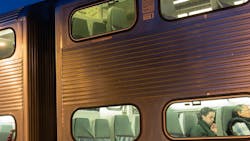Caltrain ships off 32 gallery cars to make room for electric train fleet
Caltrain has shipped 32 of its nearly 40-year-old gallery cars to Sonoma, Calif., as the agency makes room for its new electric fleet. The cars will be stored in Petaluma with Sonoma-Marin Area Rail Transit until they are put up for sale and a buyer is found.
Caltrain currently has eight of the eventual 23 electric trainsets on its property. As additional electric trainsets make their way to Caltrain’s Central Equipment Maintenance and Operations Facility, Caltrain notes it had to begin relocating older vehicles to ensure there was enough room for both the new equipment and standard operations. The gallery cars that were shipped off were not in service and their retirement will not affect Caltrain service. The passenger cars were built in San Francisco by Nippon Sharyo and had been in service since 1985.
Caltrain hosted a small event for the public at the Santa Clara Station Historic Rail Museum to send off the trains. The rest of the Nippon Sharyo passenger cars will be retired at the start of electrified service in fall 2024.
Caltrain’s historic Electrification Project is the first undertaking in North America in a generation in which diesel trains and their infrastructure components are transitioned to an electrified system. Electrification means faster and more frequent service, including doubling the frequency on weekends. Caltrain notes the passenger experience will be greatly improved as well, with the new trains featuring Wi-Fi, power outlets at every seat, onboard displays with digital trip information and increased storage capacities.
Electrification will also help meet ambitious regional and state climate action goals by lowering greenhouse gas emissions, improving air quality and relieving traffic congestion. Additionally, electrified service will advance equity along the Caltrain corridor by reducing noise and air pollution while increasing access for priority equity communities. It will also set the framework for California’s future high speed rail network that will run on the Caltrain corridor.
The proposed electrification service plan would see weekday peak hour trains go to 79 stations per hour, an increase from the current 66, as well as 11 stations would experience four train arrivals hourly per direction, an improvement from seven stations currently. Midday trains would cover 44 stations per hour, up from the current 34.
